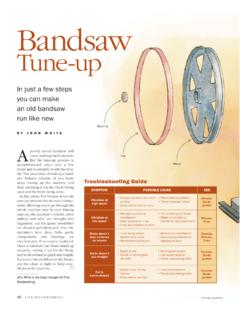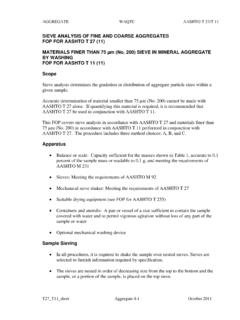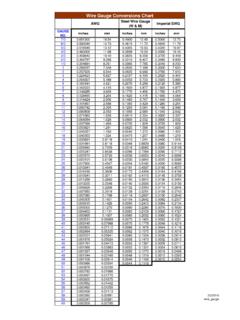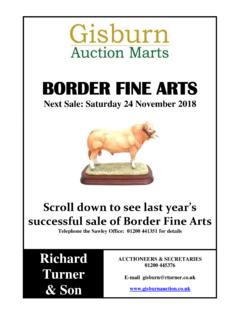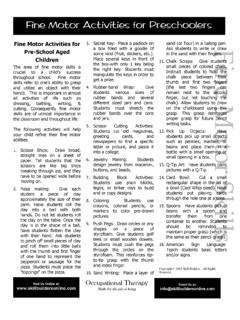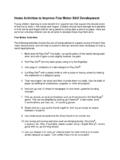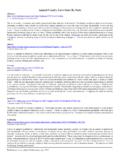Transcription of Fine-Tuning a Bandsaw
1 Fine-Tuning a BandsawVibration and wandering cuts are signsyour Bandsaw needs a checkupby Robert VaughanAn improperly adjusted bandsawwill do everything but cut well. Itmay throw, break or dull bladesquickly. Or it may produce cuts thatwander like a drunk failing a roadsidesobriety 've performed surgery on a lot ofbandsaws, and I have discovered there'sno single saw component that causesmost ills. Many jumping and trackingproblems can be traced directly to worn-out tires. But a vibrating Bandsaw may justas likely be handicapped by a beaten-updrive belt.
2 A saw that refuses to cutsquarely may be affected by a guidepostthat is out of alignment, or the saw mayhave one of its wheels out of line (see thebox on pp. 78-79).Solving many of these problems doesn'trequire a lot of fancy equipment. Basictools such as wrenches, try squares, a fileand some washers for shims are often allyou need. A few diagnostics and adjustingtechniques will bring out the bestperformance your saw has to offer. Thebasics include checking your tires forwear, wheel alignment, guidepostalignment and adjusting the guides andblade tension.
3 Begin your tune-up byunplugging your must be smoothand crownedI begin a tune-up by opening the wheelhousings and blasting the works withcompressed air to clear out the I look at the wheels and tires. If awheel is broken or badly bent, there's notmuch you can do except replace your Bandsaw tracks poorly or jumpsexcessively, chances are the tires areworn. The majority of Bandsaw trackingand jumping problems begin and endhere. Tires should be whole, not missinglarge chunks, and without hairline need a crowned surface.
4 Asmooth tire with a slightly crowned sur-face, like this one, will make a bandsawtrack accurately and run tires need author recommends replacing tiresbefore they get this surface should be smooth, clean andslightly crowned (see the top photo). Thecrown defines where the blade have a tendency to wander backand forth on the surface of uncrownedtires. A crown also keeps the teeth fromcutting grooves in the tire's surface. Agrooved surface will make trackingunpredictable (see the bottom photo).
5 If you cut a lot of resinous woods, youmay have a gummy buildup on the tires,which can create a false crown. Thatcondition can foul the blade's tracking,allowing it to drift. You can check this byturning on the machine and letting it whether a Bandsaw needs its wheelscrowned, you don't have to remove thewheel. First remove the wheel guards, andback off the blade-guide a -in. blade, and set the tensionnormally. Adjust the tracking so the bladestays in the middle of the tire when thewheels are turned by hand.
6 With a scrapof wood, push on the back of the bladeusing the same kind of force you'd use forcutting wood (see the photo at right).Hold the block in place for three or fourrevolutions of the blade, and then releasethe pressure against the blade and turn it afew more the blade's position on the tire surfacedoesn't change even though the bladedeflects slightly from the pressure of thewood block, then the crown is in goodshape. If the band moves off the centerposition under pressure and returns whenpressure from the wood block is released,the crown is showing signs of wear but isstill functional.
7 If the blade moves anddoesn't return to its original position, thencrowning is needed. You can do thisyourself (see FWW #95, pp. 50-53).Tires need replacing from time to the crown and drive train ToMost machines that have less than a use a rubber-band type of machines may have tires of aspecialized configuration; some have afitting groove in the middle of the wheel'ssurface. When ordering replacements,note your saw's model number; I've seendifferent tires used on similar you're in the machine's innards,examine the saw's pulleys.
8 Those that areworn or bent can cause vibration. Wornbelts develop knots at the factory joint,creating a bumping sensation. Replacethese inexpensive items when they showsigns of wear. And check all bolts andsetscrews for the blade to the guidepostThe guidepost should move up and downin a line parallel to the blade. Otherwise,Checking for crown wear Theauthor spins the bottom wheel by handblock of wood using normal cuttingthe blade's position won't upper guide components must bereadjusted with each change in stockthickness a nuisance that eventually getsignored until blades start breaking orcutting-precision deteriorates.
9 For mostsmall bandsaws , there are few, if any,adjusting mechanisms for the guidepostitself. But you can reposition the wheelsto compensate for an out-of-lineguidepost. This is a tedious, trial-and-error process, but just think of all the timeyou'll save not having to readjust yourguide components every time you raiseor lower the the guidepost's alignmentstarts with the table. Remove the upperguide bracket, and raise the guidepost allthe way up. Turn the wheels by hand for afew revolutions to make sure the blade'stracking is properly adjusted.
10 Using twotry squares, check to see if the table isperpendicular to the blade (see the photoon p. 78). Adjusting the table side to sideis done through the trunnion stops. Toadjust it front to back, install flat washersbetween the trunnion bolts and thebottom of the table to raise a section thatsuffers from a dip (see the top photo onp. 79). If so equipped, be sure that thetaper pin or locking bar is installed in thesplit of your tabletop. Tabletop flatness inthis region is controlled by tapping thepin in or out.

